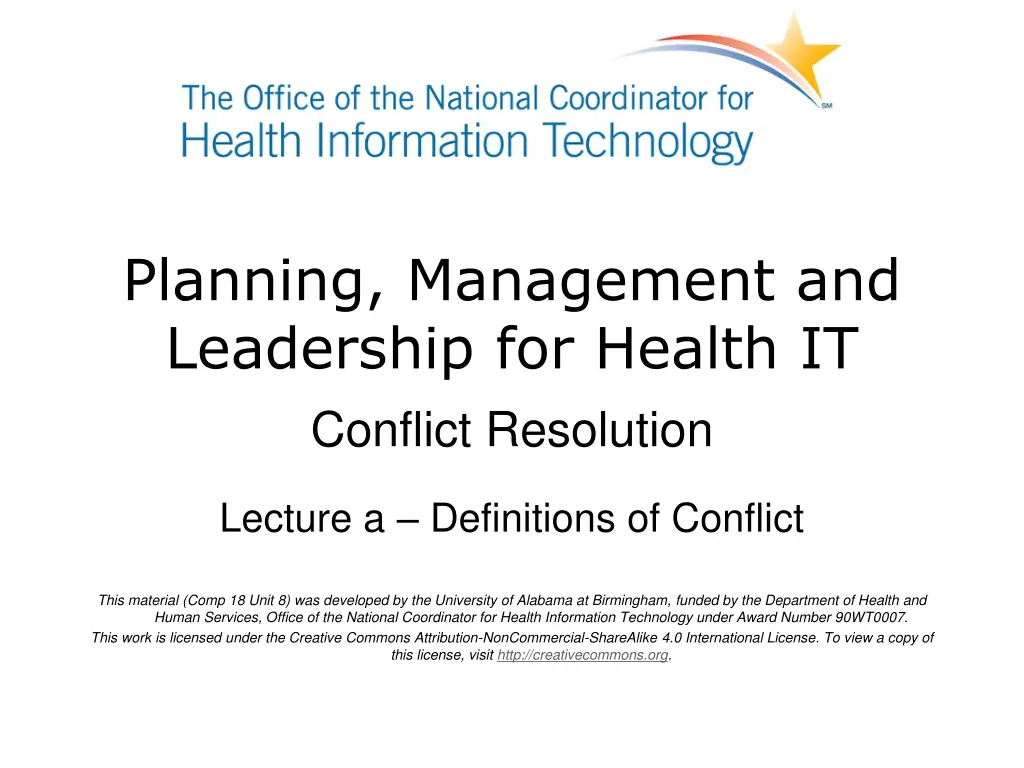
Conflict Resolution in Healthcare Workplaces
Explore the definitions and historical views of conflict in healthcare workplaces. Understand how conflict is perceived, requiring human interaction with disagreement or incompatibility. Dive into the high-conflict environments of healthcare workplaces, characterized by stress, emotion, limited resources, competition, and diverse stakeholders. Examine the transitions in ideas about conflict, moving from traditional views that saw all conflict as negative to human relations views where conflict was seen as a normal part of organizational activity and could even improve performance.
Download Presentation

Please find below an Image/Link to download the presentation.
The content on the website is provided AS IS for your information and personal use only. It may not be sold, licensed, or shared on other websites without obtaining consent from the author. If you encounter any issues during the download, it is possible that the publisher has removed the file from their server.
You are allowed to download the files provided on this website for personal or commercial use, subject to the condition that they are used lawfully. All files are the property of their respective owners.
The content on the website is provided AS IS for your information and personal use only. It may not be sold, licensed, or shared on other websites without obtaining consent from the author.
E N D
Presentation Transcript
Planning, Management and Leadership for Health IT Conflict Resolution Lecture a Definitions of Conflict This material (Comp 18 Unit 8) was developed by the University of Alabama at Birmingham, funded by the Department of Health and Human Services, Office of the National Coordinator for Health Information Technology under Award Number 90WT0007. This work is licensed under the Creative Commons Attribution-NonCommercial-ShareAlike 4.0 International License. To view a copy of this license, visit http://creativecommons.org.
Definitions of Conflict Learning Objectives Define conflict Explore historical views of conflict Explore conflict as positive/negative force 2
Conflict and Conflict Definition Definition of the term conflict Conceptual Commonalities/themes Conflict must be perceived by the individuals involved with it Requires human interaction with some level of disagreement or incompatibility o o Source: (Robbins & Judge, 2007) 3
Healthcare Workplaces High-conflict environments High levels of stress and emotion Limited resources Competition Mergers Regulation Numerous stakeholders Cultural and diversity concerns Source: (Gardner, 1992) (Forte 1997) 5
Transitions in Ideas About Conflict Traditional View Human Relations View Interactionist View Source: (Robbins & Judge, 2007) 6
Transitions in Ideas About Conflict 2 Traditional View 1930s and 1940s Assumed all conflict to be bad and viewed negatively Although currently an out-of-date assumption, many people still see conflict this way 7
Transitions in Ideas About Conflict 3 Human Relations View 1940s to the 1970s Conflict was a normal part of group and organizational activity Conflict could not be avoided Conflict might actually improve a group s performance 8
Transitions in Ideas About Conflict 4 Interactionist View Conflict is inevitable Conflict leads to work groups that are Self-critical Inventive Imaginative Importance of leadership o o o 9
Conflict: Good Constructive (functional) Good form of conflict Leads to improved group functioning Conflict is supportive of group goals Sources: (Cosier & Dalton, 1990) 10
Conflict: Bad Destructive (dysfunctional) Bad form of conflict Obstructs group performance May be detrimental to patients Sources: (Cosier & Dalton, 1990) (Forte, 1997) 11
Differentiating the Good from the Bad Relationship Conflict Interpersonal relationships Process Conflict How work is carried out Task Conflict Content and objectives of work Sources: (Robbins & Judge, 2007) (Yang & Mossholder, 2004) 12
Differentiating the Good from the Bad 2 Relationship Conflict Almost always negative Process Conflict Low levels can be positive and functional Task Conflict Low to moderate levels can be positive and functional Sources: (Robbins & Judge, 2007) (Yang & Mossholder, 2004) 13
Other Types of Conflict Source: (Kolb & Bartunek,1992) 14
Conflict Resolution Summary Lecture a Define conflict Explore historical views of conflict Explore conflict as positive/negative force 19
Conflict Resolution Lecture a References References Cosier RA, Dalton DR. Positive effects of conflict: a field assessment. Int J Conflict Mgmt.1990;1(1):81-92. Forte PS. The high cost of conflict. Nursing Economics. 1997 May/Jun;15(3):119-23. Gardner DL. Conflict and retention of new graduate nurses. Western Journal Nursing Research. 1992 Feb;14(1):76-85. Kolb DM. Bartunek JM. Hidden conflicts in organizations: Uncovering behind the scenes disputes. Newbury Park (CA): Sage Publications; 1992. Robbins SP, Judge TA. Organizational behavior. 12th ed. Upper Saddle River (NJ): Pearson Prentice Hall; 2007. Yang J. Mossholder KW. Decoupling task and relationship conflict: the role of intragroup emotional processing. J Organizational Behavior. 2004;25(5):589-605. 20
Planning, Management and Leadership for Health IT Conflict Resolution Lecture a This material was developed by the University of Alabama at Birmingham, funded by the Department of Health and Human Services, Office of the National Coordinator for Health Information Technology under Award Number 90WT0007. 21






















